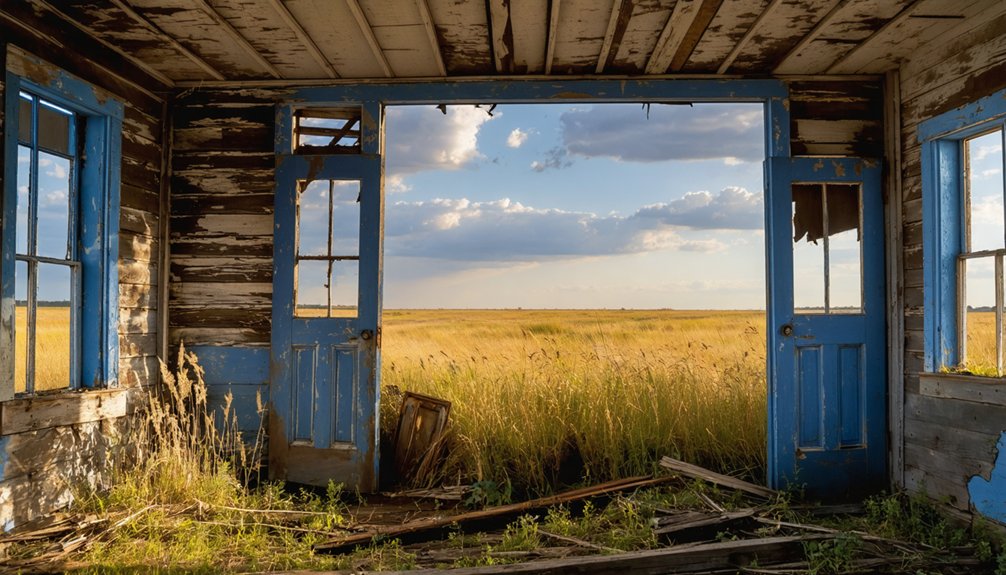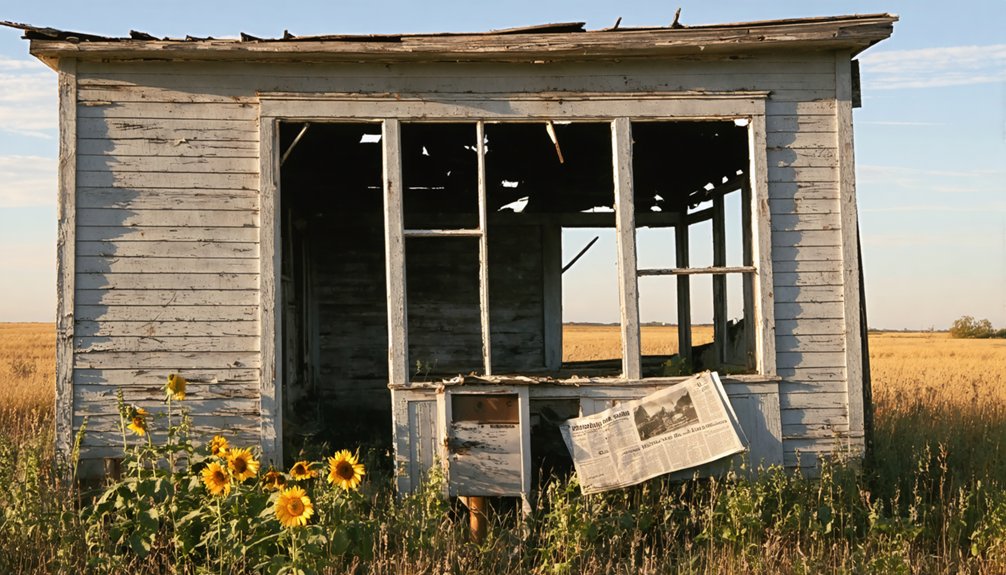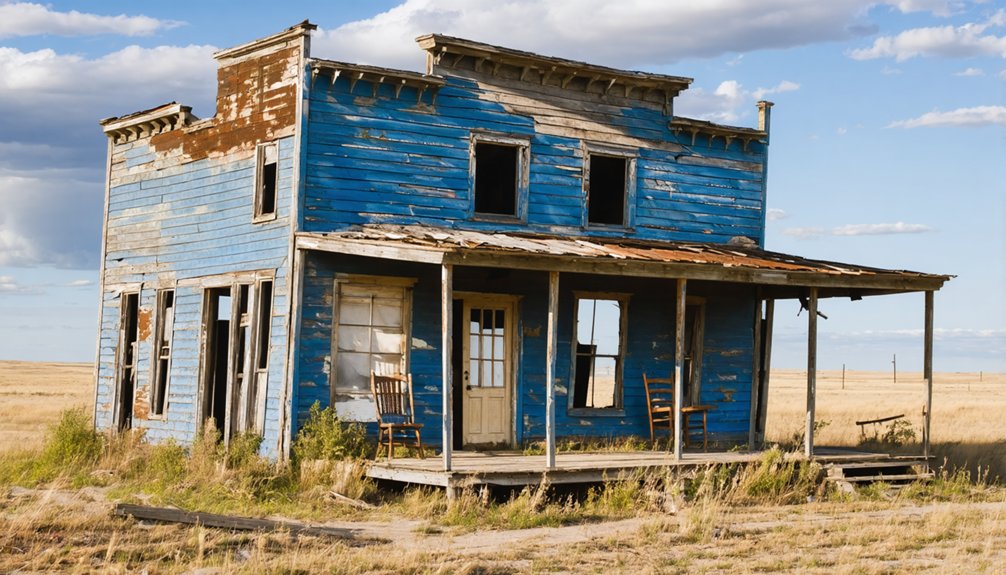You’ll find Heppner ghost town in South Dakota’s southwestern Black Hills near Hot Springs, at coordinates 43°14’48.9066″N, 103°32’59.7073″W. This mysterious settlement, established around 1914, peaked with roughly 100 residents before declining after its post office closed in 1952. The town’s main economic driver was a sawmill, surrounded by pine forests and rocky terrain typical of the Black Hills region. While limited historical records exist, the site holds untold stories of pioneer life.
Key Takeaways
- Heppner is an abandoned ghost town in Fall River County, South Dakota, located in the southwestern Black Hills near Hot Springs.
- The town was officially established in 1914 with a post office and reached a peak population of approximately 100 residents.
- A sawmill served as the primary employer until 1952, when its closure triggered the town’s ultimate decline and abandonment.
- Visitors can find the ghost town at coordinates 43°14’48.9066″N, 103°32’59.7073″W, surrounded by pine forests and mining remnants.
- Limited historical records exist about Heppner, though Olga Parker’s 1991 documentation provides valuable information about the settlement.
The Mystery Behind Heppner’s Origins
The origins of Heppner, a Fall River County ghost town, remain shrouded in historical uncertainty.
In Fall River County’s ghost town landscape, Heppner stands as an enigma, its beginnings lost in the mists of time.
You’ll find no definitive records of its exact founding date, unlike other Black Hills settlements such as Trojan or Gregory. The name origin of Heppner presents another mystery, with no clear connection to any founder or prominent local figure.
Settlement theories point to the town’s establishment during the region’s mining and railroad expansion era in the late 19th or early 20th century. Like many of the six hundred ghost towns documented in the Black Hills, details about its early development have faded with time.
While you can trace Heppner’s existence through its post office presence and appearances on period maps, the details of its founding are lost to time.
Like many Black Hills communities, it emerged amid the rush for gold and transportation routes, though specific mines linked to the town aren’t clearly documented. Similar to towns like Ordway, Heppner’s fate was likely sealed when the railroad extended beyond it.
Geographic Location and Terrain
Nestled in Fall River County’s rugged terrain, Heppner’s remains lie within the southwestern reaches of South Dakota’s Black Hills.
You’ll find this ghost town near Hot Springs, surrounded by the region’s distinctive topographical features that include rocky outcrops and dense forest areas. The landscape bears the markings of its mining past, where the natural elevation supports a diverse mix of woodland and prairie ecosystems typical of the Black Hills.
The site can be precisely located at 43°14’48.9066″N, 103°32’59.7073″W coordinates for those seeking to visit the historic location.
Like the town of Scenic, Heppner stands as another testament to the economic decline that plagued many South Dakota settlements.
If you venture to explore Heppner today, you’ll encounter terrain that’s been shaped by both nature and human activity.
The regional climate has sustained a mix of pine forests and grasslands, while past mining operations have left their mark on the land through scattered foundations and modified soil conditions characteristic of Black Hills ghost towns.
Life in Early Settlement Days
During Heppner’s peak settlement years, pioneer families carved out a life of subsistence farming and livestock raising amid the challenging Black Hills terrain.
Like other early settlers in Bon Homme County, these pioneering families faced the same uncertainties of establishing new homesteads in Dakota Territory.
You’d find settlers facing numerous hardships, from brutal winters that threatened their livestock to periods of drought that damaged crucial crops. Despite these challenges, community resilience emerged through cooperative practices and mutual support.
Local families gathered at the town’s small church for both worship and social activities, while sharing labor during harvests and barn-raising events.
Like many South Dakota settlements, Heppner’s residents relied heavily on their general store and post office as essential hubs for supplies and communication. The town’s prospects were shaped by the presence of railroad tracks, which connected settlers to vital markets and resources.
Daily life centered around manual farm work, with families tending to crops, caring for animals, and maintaining their modest timber homes through all seasons.
Local Economic Activities
You’ll notice a significant gap in historical records regarding Heppner’s full economic scope, as business documentation from the 1900s remains largely missing.
Similar to the economic fluctuations experienced in Galena’s mining operations, Heppner faced its own periods of boom and decline.
While the sawmill dominated local industry until 1952, researchers haven’t uncovered evidence of other major industrial development in the area.
The extent of agricultural activity around Heppner is also unclear, with no surviving land-use records to indicate whether farming played any significant role in the local economy.
Agricultural Land Usage Unknown
While evidence exists of agricultural activities in the broader South Dakota region during Heppner’s existence, specific details about the town’s agricultural land usage remain undocumented. The era saw many farmers face severe economic hardships between 1920-1923, impacting rural communities across the region.
You’ll find that South Dakota’s agricultural innovations and land usage patterns during this era were shaped by significant legislation and technological advances. The introduction of artesian-well irrigation transformed farming capabilities in many South Dakota communities during the late 1800s.
Based on regional patterns, you might consider these likely agricultural activities in Heppner:
- Stock raising operations, supported by the Stock Raising Act of 1916, which increased allowable acreage for ranchers
- Crop farming adaptations in response to the region’s arid conditions, potentially leading to livestock diversification
- Mixed farming practices that included seed production, poultry, and dairy operations, reflecting the broader trend of agricultural diversification in South Dakota
These activities would’ve aligned with the economic and environmental realities of the Great Plains region.
Missing Business Records 1900s
Despite extensive research into South Dakota’s business incorporation records from the early 1900s, Heppner’s commercial activities remain largely undocumented.
You won’t find any conclusive evidence of registered businesses in the Dakota Territory Articles of Incorporation index, which lists over 3,000 companies from 1878-1889.
While the South Dakota State Business Directory (1909-1910) covered regional commerce, there’s no confirmed mention of Heppner’s enterprises.
Modern searches through the Secretary of State’s database haven’t revealed historical registrations for the town.
If you’re looking to uncover Heppner’s economic past, you’ll need to explore unpublished records at the State Archives or local historical societies.
Like many small rural settlements, Heppner’s business activities were likely informal and conducted without official documentation.
Researchers may want to utilize FamilySearch genealogy resources to explore historical records that could reveal business activities through census data and personal documents.
No Industrial Development Found
Based on extensive research into Fall River County‘s industrial records, Heppner shows no evidence of major economic development beyond the basic amenities typical of small South Dakota settlements.
Like many ghost towns that didn’t strike gold or establish rail connections, Heppner’s economy likely centered around small-scale commerce and local services.
- Historical records suggest the settlement pattern followed other non-industrial towns, with possible general stores and a post office serving nearby homesteaders.
- No mining operations, sawmills, or quarries were documented in Heppner’s vicinity, limiting its potential for sustained growth.
- Without major transportation infrastructure or mineral resources, the town couldn’t attract the industrial investment needed to build a diverse economic base.
The absence of industrial development made Heppner vulnerable to the economic pressures that ultimately led to its abandonment.
Community Development and Decline
You’ll find limited historical records about Heppner’s early settlement patterns, as no formal documentation exists regarding its initial population influx or community growth.
While you can trace the town’s official establishment to 1914 with its post office opening, the specifics of how the community developed between then and its abandonment remain unclear.
The timeline of Heppner’s decline isn’t well documented, though the post office’s closure in 1952 marks a significant milestone in the town’s path to abandonment.
Settlement Origins Remain Unknown
The mystery surrounding Heppner’s origins reflects a common challenge in documenting South Dakota’s ghost towns.
You’ll find that historical records are scarce, leaving settlement theories largely based on regional patterns rather than concrete evidence. While nearby ghost towns often emerged due to mining or railroad activity, Heppner’s specific economic foundations remain one of the Black Hills’ enduring historical mysteries.
- No visible structures or building foundations remain to help validate the town’s original purpose
- Government and postal records provide minimal documentation of the settlement’s establishment
- Local accounts and oral histories are fragmented or non-existent, unlike other ghost towns in the region
Without clear documentation or physical remnants, you’re left to piece together Heppner’s story through the broader context of South Dakota’s boom-and-bust settlement era.
Population Growth Never Documented
While census records provide detailed population data for most South Dakota settlements, Heppner’s growth and decline remain undocumented through official channels. Population estimates suggest the town peaked at roughly 100 residents, based on anecdotal accounts and comparisons with similar communities in the region.
You’ll find that Heppner’s trajectory mirrors other ghost towns in South Dakota, where economic limitations shaped community size. The lack of railway expansion and the 1952 closure of the sawmill – the town’s main employer – triggered a steady exodus.
Infrastructure never expanded beyond basic services, and recurring floods discouraged long-term settlement. Like neighboring towns such as Okaton and Cottonwood, Heppner’s population dwindled as families sought opportunities elsewhere, leaving behind no formal documentation of its demographic decline.
Abandonment Timeline Largely Missing
Despite extensive research efforts, details about Heppner’s community development and eventual abandonment remain largely missing from historical records.
Like many ghost town narratives in Fall River County, the Heppner mysteries include fundamental gaps in understanding when and why residents left this South Dakota settlement.
You’ll find these critical pieces of information absent from the historical record:
- No documentation exists showing whether the town’s decline was sudden or gradual.
- There’s no evidence of specific triggering events like economic shifts or natural disasters.
- Records don’t indicate when the last residents departed or why they chose to leave.
The single known photograph from 1991 provides minimal context, leaving researchers unable to construct a reliable timeline of Heppner’s final days as an active community.
Remnants and Historical Artifacts
Remnants of Heppner’s once-bustling community provide limited but meaningful glimpses into its past, with the town’s post office serving as a central fixture from 1914 until 1952.
You’ll find the town’s layout still reflects its original 1914 planning, though most structures have disappeared into South Dakota’s landscape. For ghost town tourism enthusiasts, the site offers an authentic example of the region’s abandoned settlements.
The most significant historical preservation resource comes from Olga Parker’s 1991 documentation, which captured the town through photographs and detailed notes.
While physical artifacts remain scarce, the legacy of Charles Heppner, the town’s namesake and post office founder, lives on through historical records.
Today, the remnants stand as silent witnesses to the broader story of South Dakota’s rural development and decline.
Exploring the Ghost Town Today

Today’s visitors to Heppner face a challenging but rewarding journey into South Dakota’s ghost town exploration heritage. You’ll need to navigate unpaved rural roads and prepare for self-guided outdoor adventure through overgrown terrain. The site’s remote Black Hills location requires careful planning, as you won’t find marked trails or visitor facilities.
Exploring Heppner demands preparation and self-reliance, as this remote Black Hills ghost town offers raw adventure without modern amenities.
- Pack essential gear for rough terrain hiking and seasonal weather conditions
- Research land ownership beforehand, as some areas require permission to access
- Document your findings carefully, as scattered ruins and artifacts are often obscured by vegetation
While exploring, you’ll discover foundational ruins, mining equipment remnants, and various historical fragments.
The surrounding Black Hills region offers additional ghost towns and natural attractions, making Heppner an intriguing stop in a broader historical expedition.
Legacy and Historical Significance
While Heppner lacks the dramatic mining narratives common to many Black Hills ghost towns, its legacy tells an equally important story of Great Plains settlement and decline.
You’ll find Heppner’s significance lies in how it represents the broader pattern of small agricultural communities that once dotted South Dakota’s landscape. From 1914 to 1952, the town’s post office served as a crucial communication hub, demonstrating the community resilience of early prairie settlers.
Though few physical traces remain today, Heppner’s story mirrors the challenges faced by countless rural settlements across the Great Plains. As agricultural practices evolved and transportation improved, these small community centers gradually faded away, leaving behind a reflection of the changing dynamics of rural American life.
Research Challenges and Missing Records

Despite its historical significance, researching Heppner’s past presents numerous challenges for historians and archaeologists. Limited archival access and deteriorating physical evidence make ghost town preservation efforts particularly difficult.
The scarcity of thorough primary records, combined with inconsistent secondary accounts, creates substantial gaps in understanding Heppner’s complete story.
- Primary documentation is largely missing, with only basic land and mining records surviving.
- Physical site deterioration and natural overgrowth have obscured or destroyed many original structures and artifacts.
- Conflicting oral histories and tourist-oriented accounts have complicated efforts to establish accurate timelines and population figures.
You’ll find these obstacles typical of many South Dakota ghost towns, where private land ownership and industrial development continue to restrict research opportunities and archaeological investigations.
Frequently Asked Questions
Was Heppner Named After a Person or Family Who Lived There?
Despite being one of South Dakota’s 50+ ghost towns, you can’t definitively know Heppner’s origins or family influence since historical records don’t clearly indicate whether the town was named after specific people.
Did Any Major Events or Disasters Contribute to Heppner’s Abandonment?
You won’t find any major natural disasters behind Heppner’s demise. Instead, economic decline, post office closure in 1952, and lack of railroad connections gradually pushed residents to seek opportunities elsewhere.
Were There Any Native American Settlements in the Heppner Area?
Through windswept prairies and rolling hills, you’ll find evidence of Paleo-Indians and Lakota peoples who moved seasonally through this area, though there weren’t permanent Native settlements directly at Heppner’s location.
Did the Town Have Connections to South Dakota’s Gold Rush Period?
You won’t find clear evidence linking Heppner to gold mining activities, despite South Dakota’s famous gold rush. Any local mining ventures weren’t documented, and the town’s economic decline wasn’t directly tied to mining.
Were There Any Documented Paranormal Occurrences or Local Legends About Heppner?
Like a blank canvas, you won’t find any documented ghost sightings or local folklore about this place. Historical records and available sources don’t mention any paranormal tales from the area.
References
- https://www.sdpb.org/rural-life-and-history/2023-08-21/some-black-hills-ghost-towns-and-their-origins
- https://www.youtube.com/watch?v=Glucs_Rq8Xs
- https://www.sdhspress.com/journal/south-dakota-history-2-2/some-black-hills-ghost-towns-and-their-origins/vol-02-no-2-some-black-hills-ghost-towns-and-their-origins.pdf
- https://www.youtube.com/watch?v=_0WNYsFLSLA
- https://icatchshadows.com/okaton-and-cottonwood-a-photographic-visit-to-two-south-dakota-ghost-towns/
- https://en.wikipedia.org/wiki/List_of_ghost_towns_in_South_Dakota
- https://explore.digitalsd.org/digital/collection/WPGhosttown/id/3331
- https://www.onlyinyourstate.com/experiences/south-dakota/capa-ghost-town-sd
- https://www.southdakotamagazine.com/one-man-towns
- https://explore.digitalsd.org/digital/collection/WPGhosttown/id/3394



